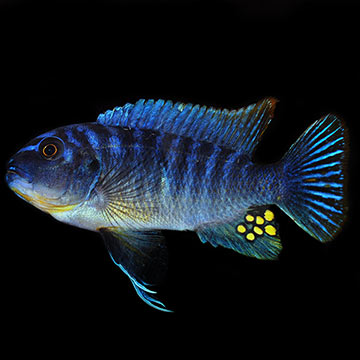
Additional locales and sizes may be available!
Additional locales and sizes may be available! Email me when availableQuick Stats
What do these Quick Stats mean? Click here for more information
What do these Quick Stats mean? Click here for more information
Overview
The Fuelleborni Cichlid, Marmalade originates from the waters of Lake Malawi, Africa. There are many color variations of the Fuelleborni Cichlid, and this variation is referred to as "Marmalade". The Marmalade variety has a blue body with dark vertical bands and an orange dorsal fin. The males bear the typical egg spots and are typically larger than the females at maturity.
Provide the Fuelleborni Cichlid with an aquarium of at least 50 gallons with a sandy substrate and plenty of stacked rocks. They are aggressive by nature and are very territorial, so provide ample caves within the rockwork to reduce this aggression.
Most members of the mouth brooding variety of African Cichlids are easily bred while in the aquarium if given the proper tank set-up and excellent water conditions. Matriarchal in family structure, the female first lays up to 60 eggs, which she then scoops into her mouth where they are fertilized. The fry remain in the female's mouth for 12 to 21 days before being released. For the following week or so, the female will scoop the young back into her mouth when any danger is sensed. A small group of 5 to 7 females and one male provide the best opportunity for breeding.
Although the Fuelleborni Cichlid is Omnivorous, the majority of their diet should be plant based. They will enjoy all manner of flaked foods, spinach, dried seaweed and lettuce tied to a rock or fed with a lettuce clip. Also supplement their diet with either dried or frozen bloodworms, brine and mysis shrimp.
Approximate Purchase Size: 3" to 4"






